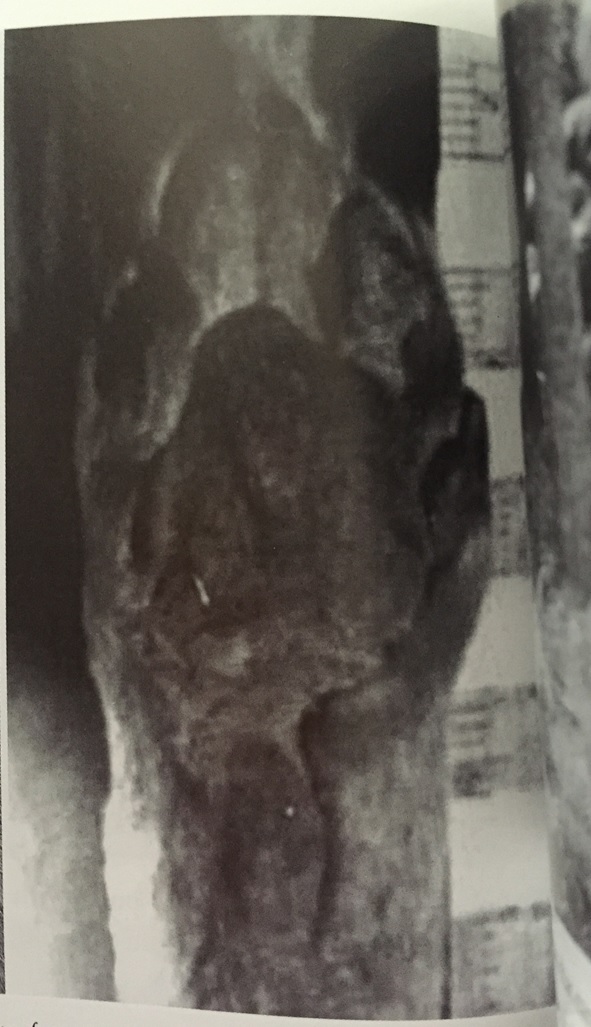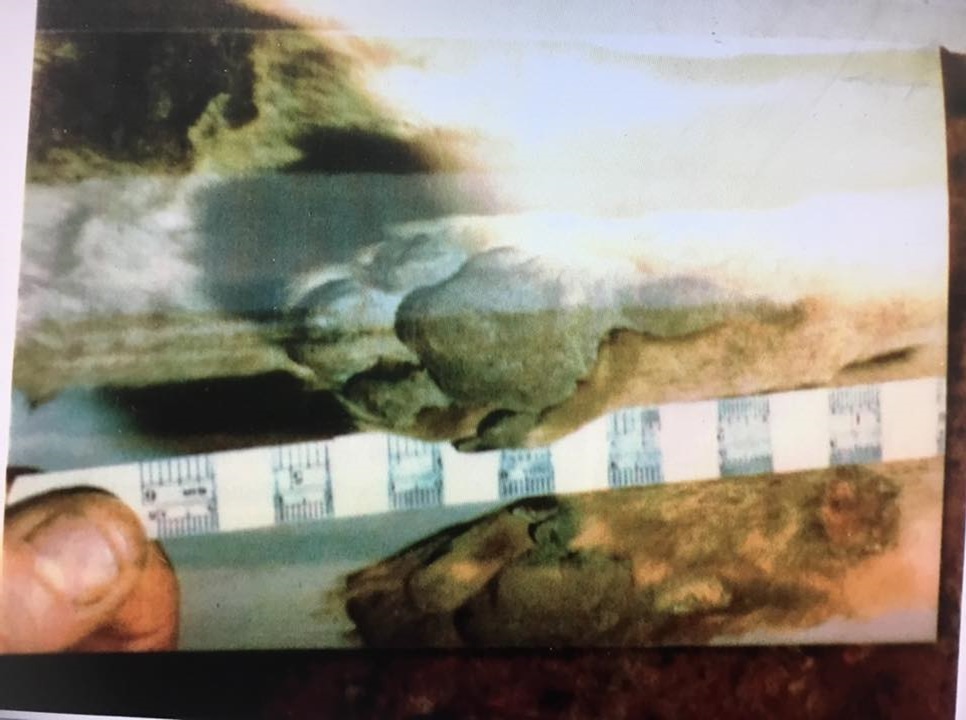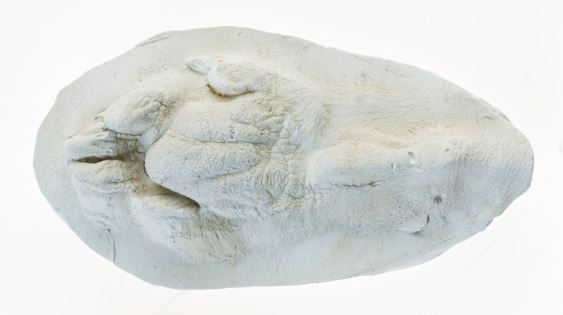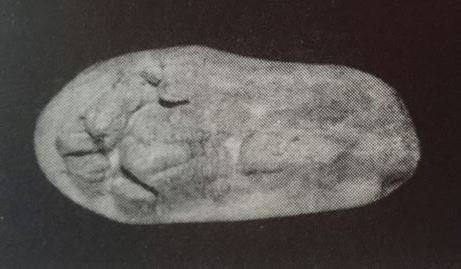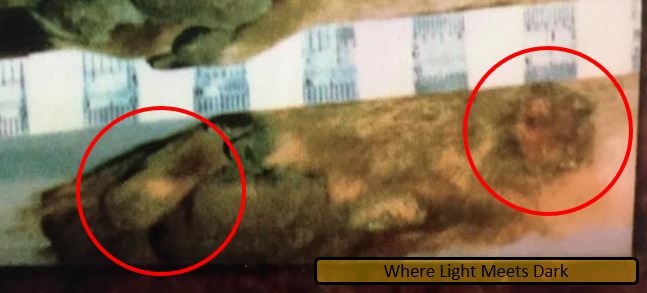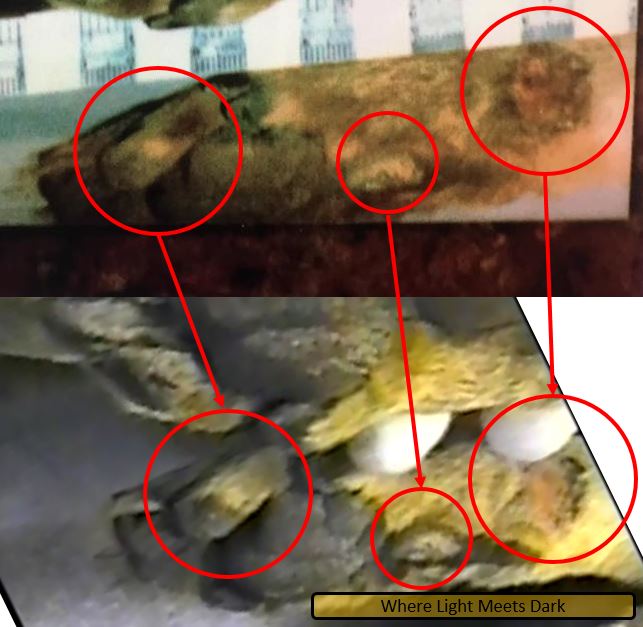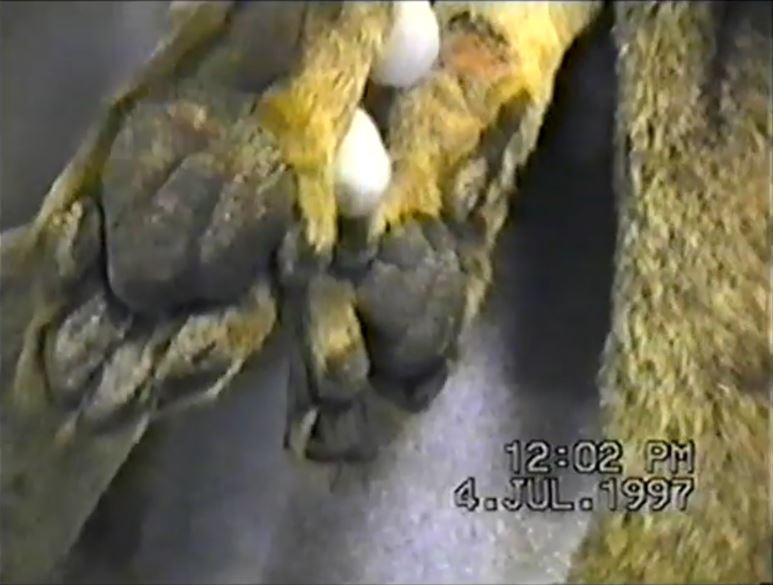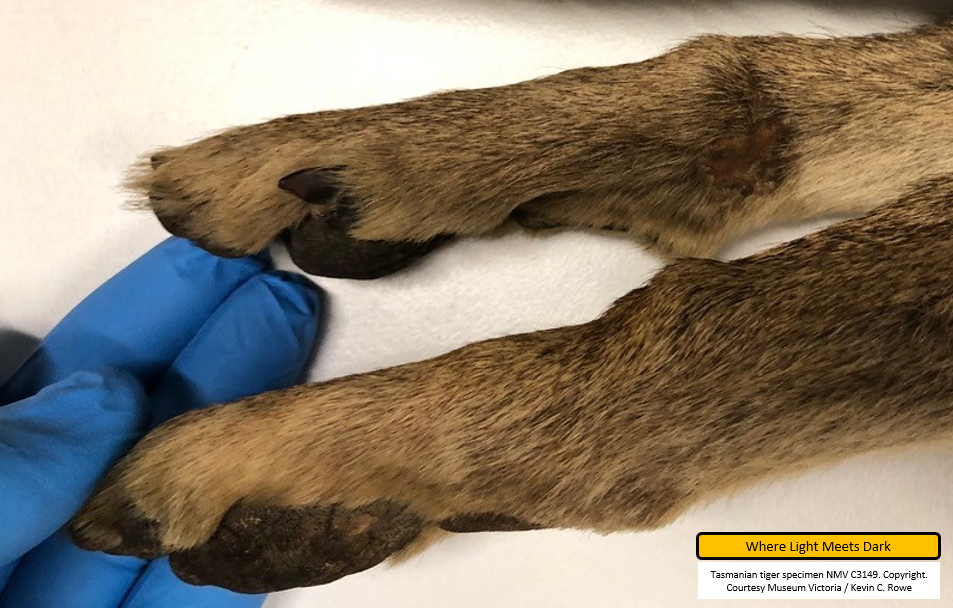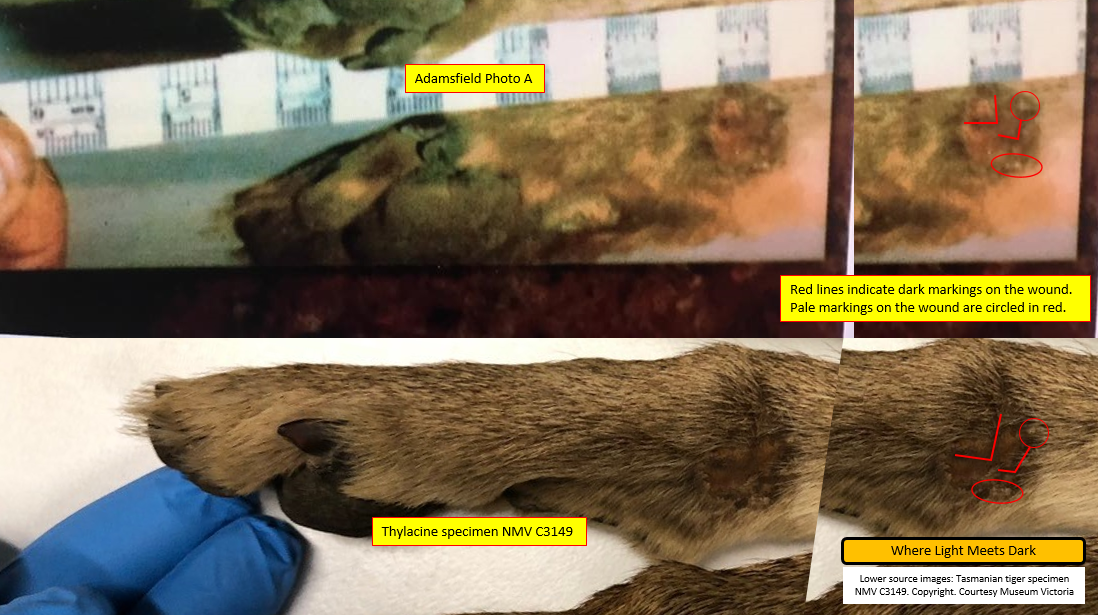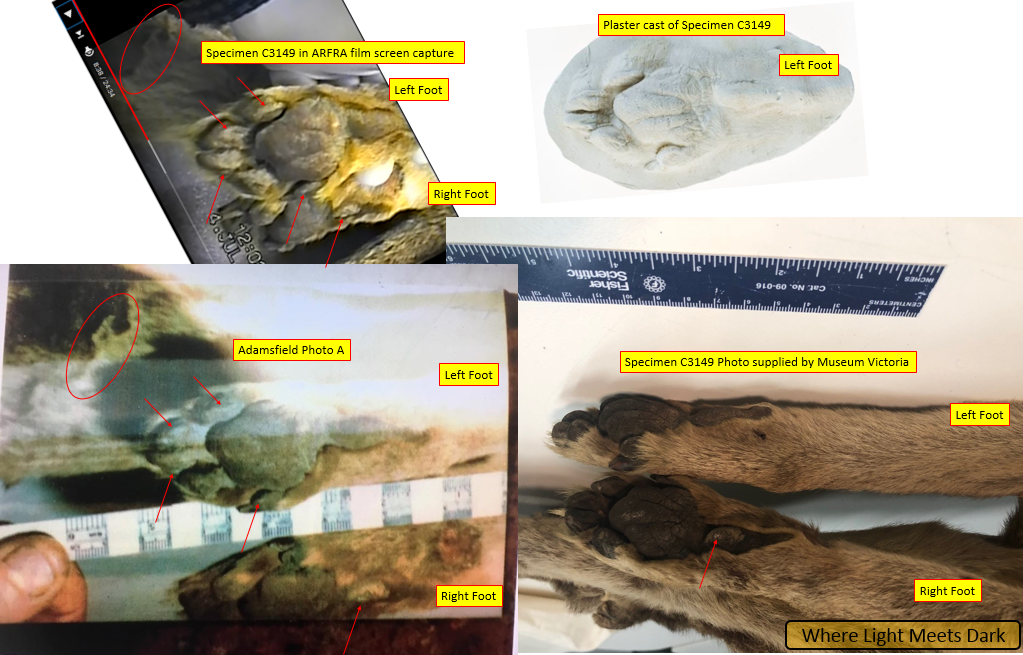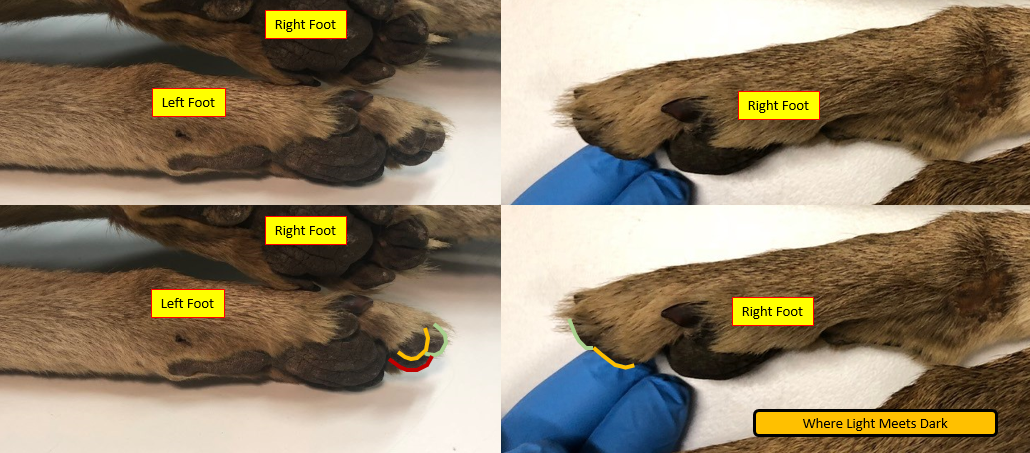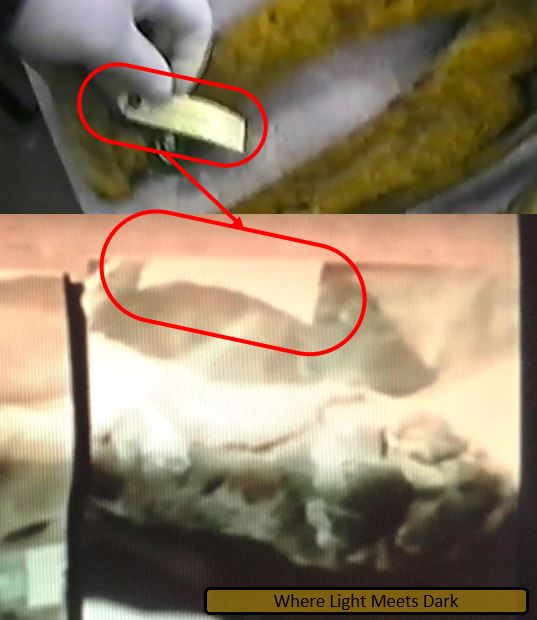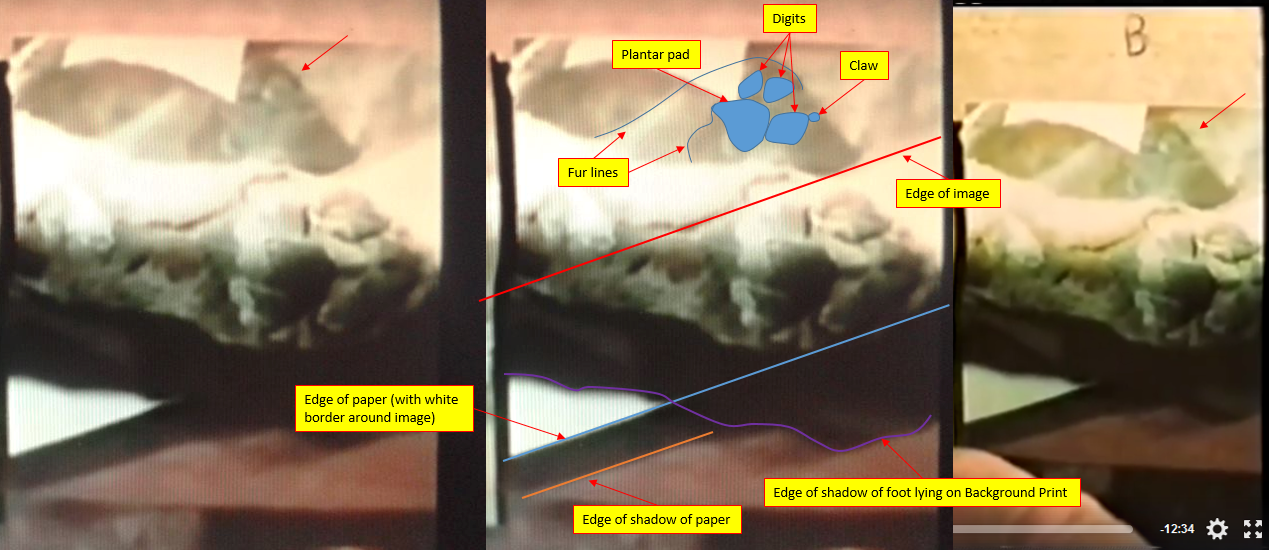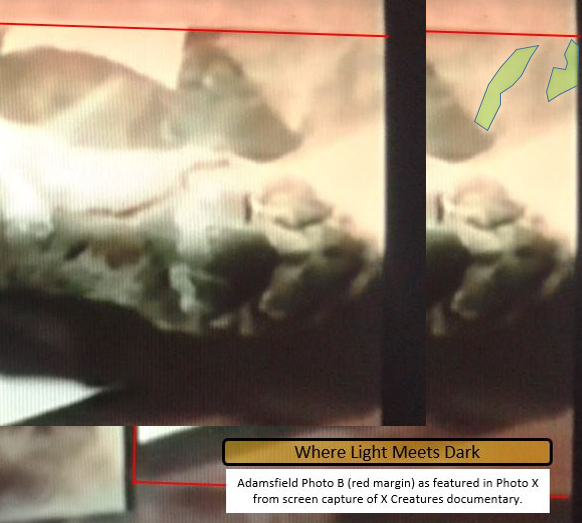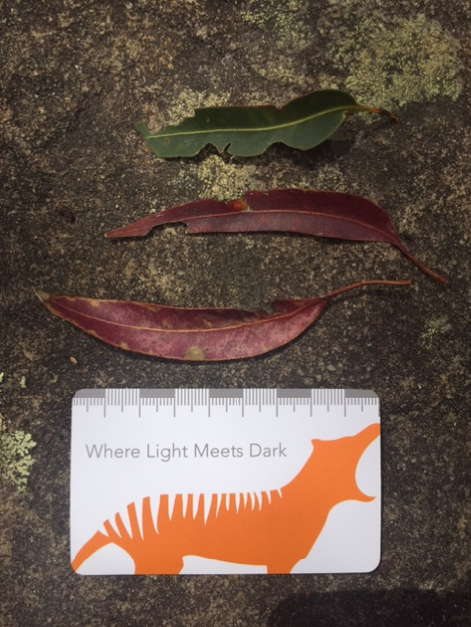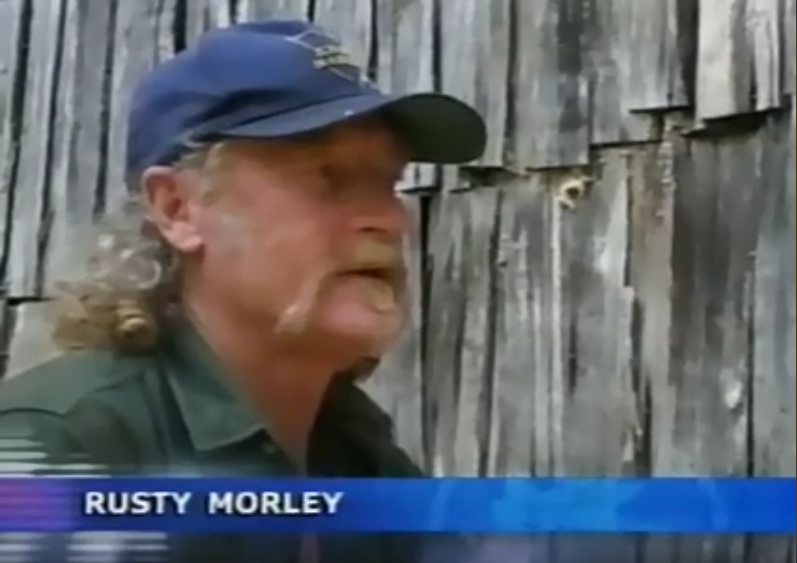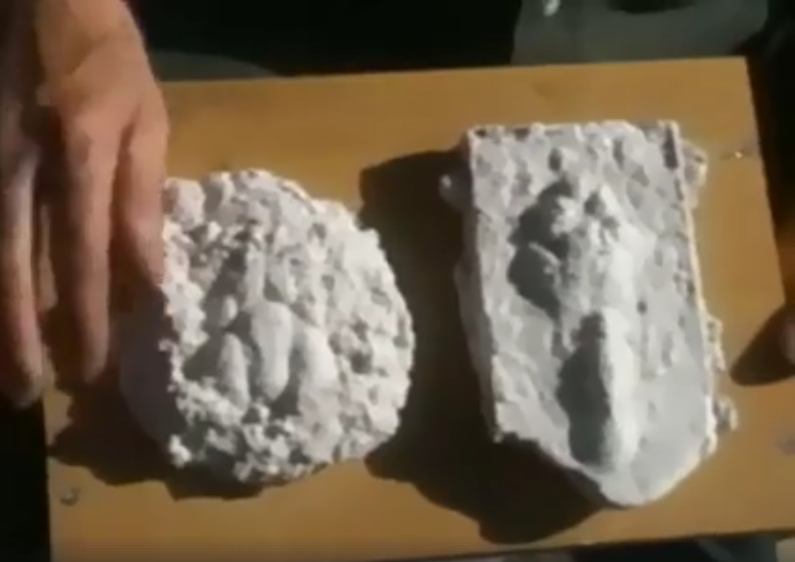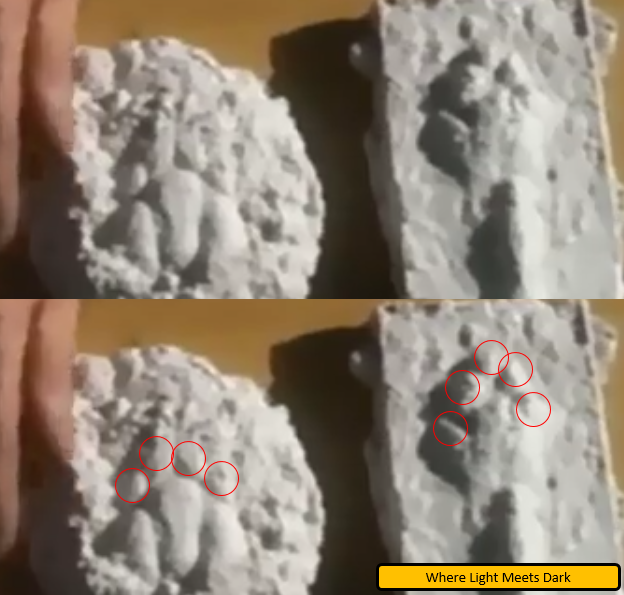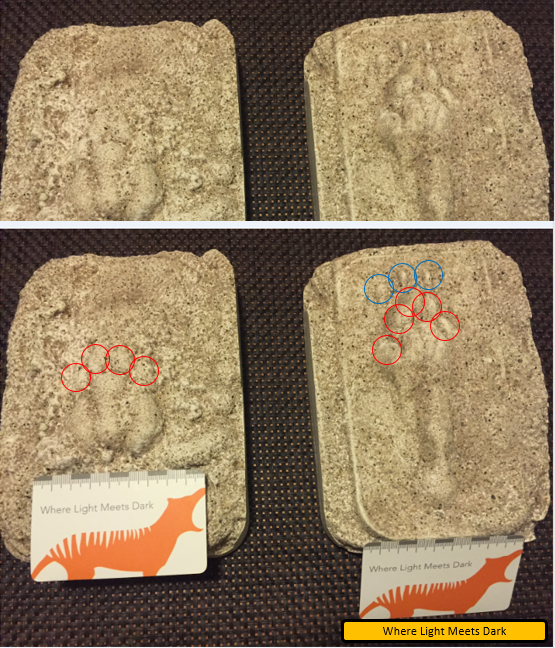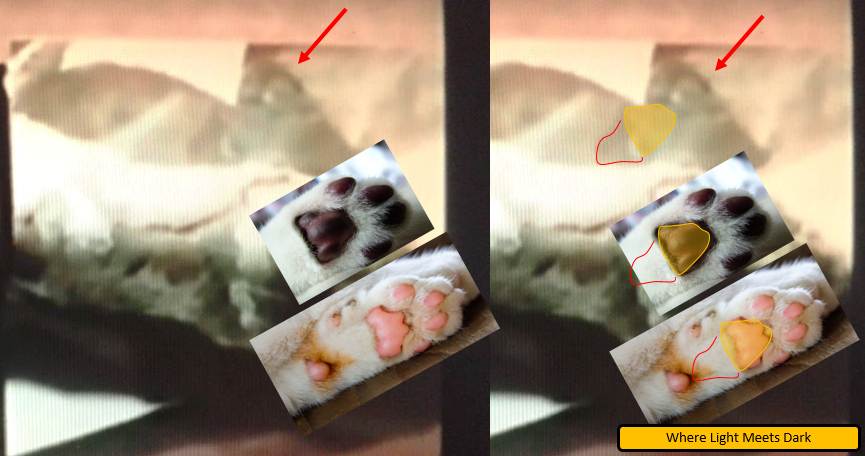Adamsfield thylacine identified
Summary
A key piece of evidence supporting the claim that there was a freshly deceased Tasmanian tiger in Tasmania in the early 1990s, consists of two photographs showing the feet of a thylacine, named Photo A and Photo B. These were first published in 1998 and until now have been interpreted to show the feet of the freshly dead animal. New evidence demonstrates that the feet belong to a museum specimen kept at Museum Victoria (specimen NMV C3149). However in one of these photos (Photo B), the museum specimen has been laid on top of yet another photograph and this third photograph - in the background and named the Background Photo - depicts another foot.
It is proposed this Background Photo constitutes the real evidence for a freshly deceased Tasmanian tiger in Tasmania in the early 1990s. Further, it is proposed the reason the museum specimen was photographed lying on top of the Background Photo was for the purpose of comparing the foot in the Background Photo with a verified thylacine specimen.
As such, Photos A and B remain important pieces of evidence in the claim of living thylacines in Tasmania in 1990 and the Background Photo constitutes strong evidence of an extant thylacine population in Tasmania in the 1990s.
The original version of this article referred to one photo as the "Background Print". This was renamed on 1 July 2019, to "Background Photo" as it was ambiguous as to whether "Background Print" referred to "Background Photographic Print" or "Background Footprint" (the correct interpretation is Background Photographic Print).
The Background Photo can be seen within Photo B. Photo B is a photograph of a thylacine foot lying on top of the Background Photo.
Overview
The television show "X Creatures" featured an episode in 1998 called "Beyond the Jaws of Extinction". In it, the creators examine claims of thylacines persisting beyond their 1936 extinction date. As evidence of the Tasmanian tiger surviving into the 1990s, two photographs are presented by respected thylacine researcher Col Bailey, showing what appear to be the feet of a Tasmanian tiger. The story accompanying the photographs as told to Bailey, was that a hunter or hunters had accidentally shot dead the animal in 1990 and taken photographs of the body. Although several photographs were allegedly taken, Bailey could only view photos of the feet, and in 2013 reproduced one of these, in black and white, in his book "Shadow of the Thylacine".
"Bailey's Book Photo" showing the foot reproduced in the book, Shadow of the Thylacine. Source: Bailey, Shadow of the Thylacine. Credit: unknown.
Following the book's publication, a number of others weighed in on the allegations surrounding a freshly deceased thylacine (or thylacines) in Tasmania in the early 1990s. In one account, newspaper editor Colin Coomber claimed he had been shown a set of about 10 photographs of an animal, unquestionably a thylacine, and later confirmed the photographs were almost certainly not from the same set as that published by Bailey. In another account, "Rusty" Morley (also known as "Tracker Scout"), who was caretaker of the remaining huts at Adamsfield, verified that he had taken photographs of a dead thylacine, but claimed that the animal was found deceased of natural causes, and that the photograph published by Bailey was not one of his.
A key feature in one of the photographs (named "Photo A") is that there appears to be a fresh wound on the wrist of the thylacine's right forepaw. This suggested the animal was freshly deceased.
"Richardson Photo" showing almost the full image of "Photo A" from which Bailey's Book Photo was cropped. Source: Facebook. Credit: unknown.
In addition to the wound on the "wrist", this forepaw exhibits a second unique feature - the "index finger" digit appears at an odd angle, partially crossed over the next digit.
The varying accounts, along with various published versions of the photographs, have been analysed extensively on WLMD under the heading of Adamsfield thylacine - initial analysis. This update proposes that the identity of the animal depicted in Photo A can be firmly established as museum specimen C3149 at Museum Victoria and that the real evidence for a freshly deceased thylacine is found in Photo B, in the form of a further photograph - the Background Photo - lying underneath the museum specimen.
Uncovering the evidence
Possible match - a plaster cast of museum specimen C3149
In researching the earlier analysis of the evidence for Adamsfield thylacines, an image of a plaster cast taken from a skin held by Museum Victoria was examined. The cast appeared similar to the Adamsfield Photo A on the basis of the foot's second digit (counting from the "thumb") extending from the paw at an odd angle, being laid across the next digit somewhat. A similarly unusual digit was noted during the analysis of Photo A.
Photo of plaster cast taken from C3149 showing 2nd digit from top lying at an unusual angle. This version has been mirrored and rotated with respect to that originally published by Museum Victoria for direct comparison with the Richardson Photo, above. Photo: Museum Victoria.
Note that the above photograph of the plaster cast has been mirror-imaged. A plaster cast should produce a "positive" image of the original foot, not a mirror image. Therefore a photograph of a plaster cast should be comparable to a direct photograph of the foot. Unless the original photo of this plaster cast had already been mirror-imaged, there is no reasonable explanation for needing to mirror the image in order to establish the match. As the anaysis continued, this was borne in mind.
Possible match - another plaster cast of museum specimen C3149
Another cast of the same specimen had earlier been photographed and published in 1994 by Joan M Dixon in an official Museum Victoria publication titled "The Thylacine - Tasmania's Tiger".
Photo of 2nd plaster cast taken from C3149 (mirror imaged from original) showing 2nd digit from top lying at an unusual angle. Photo of publication: WLMD. Photo in publication: unknown. Publication: Joan M Dixon / Museum Victoria.
This second photograph may be of the same plaster cast, or - more likely - a second instance of plaster casting this foot. This second photograph has also been mirrored and rotated with respect to that originally published by Museum Victoria for direct comparison with the Richardson Photo shown earlier in this article.
Investigating the plaster casts
In October 2017 efforts were made to investigate whether specimen C3149 might be the animal seen in "Photo A". Photographs of the specimen were examined which showed its feet held under its neck in a manner similar to that shown in Photo A. Further, a parting in the fur was noted on the animal's neck which seemed to match between the specimen and Photo A (not illustrated here).
However imagery of the specimen's "wrist" was not able to be obtained which might have served to establish whether there was a lesion or injury in that region, which might account for the wound visible in Photo A. Visiting the museum to inspect the specimen was not feasible, but initial enquiries on the data held by the International Thylacine Specimen Database suggested that no obvious wound had been noted for that specimen.
Closeup of Photo A showing the wound (at right) and unusual digit (at left). Photo A: unknown. Composite: WLMD.
New evidence - film footage of Museum Victoria specimen C3149
In February 2018, a reader of the earlier Adamsfield article made contact and brought to attention a video published in December 2015, that almost certainly depicts the Adamsfield thylacine foot - with its lesion and unusual digit - and that the foot is that of specimen C3149 at Museum Victoria.
The 24 minute video (which you can view below) was published by the Australian Rare Fauna Research Association (ARFRA) - an organisation based in Victoria that has been collecting sighting accounts of mystery animals throughout Victoria and interstate for many decades. The video features Peter Chapple - who founded ARFRA in 1984 - examining many of the thylacine specimens held by Museum Victoria.
About 8 minutes into the video, Chapple examines the feet of a number of thylacine skins. Specimen C3149 is noted for being in very good condition and showing the well defined lobes of the plantar pad on a forepaw. Although not directly commented on by Chapple, the footage also shows the wrist region of the specimen's right forefoot and a circular abnormality is clearly visible. Its location, size and appearance match that seen in Adamsfield Photo A.
The composite image below shows a portion of the Adamsfield Photo A (at top) alongside specimen C3149 (at bottom) as seen in the ARFRA film.
Composite image showing Adamsfield Photo A (top) and Museum Victoria specimen C3149 being examined by Peter Chapple (bottom) with identifying features highlighted.
The two white shapes in the screen capture at bottom are Chapple's own fingers, in white gloves. The composite image above shows the screen capture rotated to match the orientation of Photo A. From left to right, the circled areas show the unusual digit (left), a white mark on the skin behind the plantar pad (centre) and the open wound (right) on Photo A (top) and the museum specimen (bottom). Another matching detail is the way in which tufts of fur extend beyond the digits, although this is the norm for thylacines. Dr Stephen Sleightholme, Project Director to the International Thylacine Specimen Datatbase (ITSD), confirmed that: "the fur on the toes of thylacines normally extends beyond the limit of the claws, except on some taxidermy specimens, where the taxidermist has neatened the appearance of the foot by clipping the hair back to expose the claws" (personal communication, 2018).
Screen capture of the ARFRA clip showing Peter Chapple handling museum specimen C3149.
Modern photos of the museum specimen
Although the details visible in the ARFRA video are compelling, the footage is somewhat grainy and pixelated. For this reason a request was made to Museum Victoria to obtain new imagery of the forefeet of specimen C3149. New photographs were taken of the specimen and these are analysed below.
Specimen C3149 forefeet showing wound on the wrist of the right forefoot. Photo: Museum Victoria / Kevin C. Rowe.
The photo above shows the right forefoot of the specimen, with the wound visible on its wrist. This is analysed in more detail below.
Composite comparing NMV C3149 with Adamsfield Photo A. Adamsfield Photo A Source: unknown. NMV C3149 Source: Museum Victoria / Kevin C. Rowe. Composite: WLMD.
The composite image above shows Adamsfield Photo A (at top) and Museum Victoria specimen C3149 (at bottom). The wound area in each image is reproduced at right of frame. Identifying characteristics in the wound area are illustrated: red lines indicate dark markings on the wound; red circles indicate light marks on the wound. In each case these marks are visible in both images.
Although the orientation of the feet is slightly different in the two images, the inner wrist is visible in both and the identifying features of the wound make for a good match. Despite this, the fur on the foot has a more blotchy appearance in Photo A. This is likely attributable to limitations of the photography, or possibly lighting (note the strong shadows). Noting the position of skin on the pad of the 2nd digit (index finger), it can be seen this digit rests at an unusual angle, even though there is no harsh shadow along the edge of the digit.
An additional image supplied by Museum Victoria shows the underside of the forefeet. However in this photo, the specimen was laid on the other side of its body, in comparison with Adamsfield Photo A, so the wound is not entirely visible in this second new photo. A pale whitish mark on the skin behind the plantar pad is, however, visible, and also seen in Adamsfield Photo A.
The composite below includes a second screen capture from the ARFRA video (not the same as above; top left), Adamsfield Photo A (bottom left), the additional photo from Museum Victoria (bottom right) and a plaster cast of the museum specimen's left (ie. other, uninjured) foot (in correct orientation, without mirror imaging).
Composite comparing both forefeet of the animals in the ARFRA film (top-left, source: ARFRA), Adamsfield Photo A (bottom-left, copyright: unknown), a 2018 photograph of specimen C3149 (bottom-right, copyright and supplied: Museum Victoria / Kevin C. Rowe) and a plaster cast of specimen C3149 (correctly oriented - not mirror-imaged; top-right, source: Museum Victoria). Composite: WLMD.
The new museum photograph has been rotated 180 degrees in order to match the orientation of Adamsfield Photo A.
What is most notable about this collection of images are the various points highlighted on the ARFRA (top-left) and Adamsfield Photo A (bottom-left) images. The red arrows point to minor white marks on the dark skin of the thylacine's left (uninjured) forefoot digits and on the skin behind the plantar pad on the right (injured) foot. The red oval illustrates an irregularly shaped marking on the underside of the animal's neck/throat which matches in both cases. This fur marking is especially notable.
The unusual digit
As noted, the photographs of the plaster casts were mirror-imaged in order to demonstrate that there was a match with the unusually aligned digit in Photo A. Mirror-imaging should not have been required. The implication is that the first digit after the thumb on the animal's left (uninjured) forepaw must also show this unusual feature. It is clear from the photographs above that the right (injured) forepaw of the museum specimen exhibits this unusually aligned digit, but the question remains on whether the left does also.
Composite image showing the alignment of digits on the forepaws of museum specimen C3149. Source photos: Museum Victoria / Kevin C. Rowe. Composite: WLMD.
In the composite image above, an analysis is made of the alignment of some of the digits on each forepaw. Counting the "thumb" as the first digit, the pad of the second digit has been traced in orange (both feet), the third digit in green (both feet) and the fourth digit in red (left foot only). It can be seen in the left foot that the alignment of the digits is variable. Note that in the left foot we see more of the plantar pad than in the right foot because the left foot has been rolled away from the viewer somewhat. This rolling away raises the 2nd digit (traced in orange), reducing the effect.
Note also that between the two plaster casts of the same foot there is variability in the alignment of that digit. Presumably the act of casting the plaster leads to movement in the digits and this movement varied between the two casts. Flexibility of movement in the digits is sufficient to explain the discrepancies between the various images and does not take away from the identification, which is based on the wound, markings on the wound, markings on the skin and a pattern on the neck fur.
Conclusion on the identification
Although Chapple notes the museum specimen's label reads "no data", it is implausible to entertain the notion that this specimen entered the museum's collection as an animal that died post-1936 (or more specifically, after the Adamsfield photos were taken in 1990, discounting any suggestion this skin comes from an animal killed in 1990). As such, and with the number of matching idenitifying features on both feet, and in the fur of the neck, the conclusion is drawn that the primary subject of Adamsfield Photo A is specimen C3149 at Museum Victoria.
Adamsfield Photo B also likely a specimen
After showing the front feet of specimen C3149 to the camera, Chapple examines the tag attached to one of the hind feet of the specimen. The screen capture below illustrates the general size and shape of the specimen's label.
Composite image showing Museum Victoria specimen C3149 being examined by Peter Chapple (top) with the specimen label highlighted, and Adamsfield Photo B (bottom) with an unidentified white object of similar shape. Composite: WLMD.
The still frame capture does not adequately illustrate the fact that in the motion video, the label is clearly no longer flat, but has curled, presumably with age, similar to the white object at the top of Photo B. In all probability the foot in Photo B is also of specimen C3149, or at the least, another Museum Victoria specimen during the same examination involving Photo A.
New insights gained from the ARFRA film footage
A few points of information may be noted about the ARFRA footage.
Firstly, the footage is clearly timestamped as having been captured in 1997 which allows us to add it to a timeline of events.
Secondly, it shows that thylacine researcher Peter Chapple had contact with the specimen. Toward the end of the clip, author and researcher Robert Paddle also appears. For much of the clip Chapple appears free to examine and document many of the museum's thylacine specimens.
In some public discussions it was noted that the handling of the animal in Photo A appeared quite unprofessional - with an un-gloved, possibly dirty hand and a seemingly ad-hoc ruler for measure. Many museum skins are preserved using compounds of arsenic which are highly toxic and it is expected all persons handling a specimen must wear gloves. This was given as valid reason to believe the photos could not be of a museum specimen.
With the identification of the foot in Adamsfield Photo A being established above as that of the museum specimen, it is clear that for whatever reason, an un-gloved and seemingly dirty hand is seen in the vicinity of the specimen (though not touching it).
Implications of the identification
"these photographs, and particularly Photo B, do still support the claim of a freshly deceased thylacine"
Until now Photos A and B were understood to illustrate a freshly dead Tasmanian tiger. With this new insight, this is clearly not the case.
However, as seen below, these photographs, and particularly Photo B, do still support the claim of a freshly deceased thylacine. This can be seen when it is understood that the reason Photos A and B were taken, is probably for the purpose of comparing the museum specimen with a third photograph - the Background Photo seen in Photo B. It is this Background Photo that appears to show a freshly dead animal.
Illustration demonstrating the presence of the Background Photo - Illustration: WLMD. Photo Sources: X Creature. Photo Credits: Unknown.
In the above composite image, the red arrows on the left and right panels illustrate the location of the foot that can be seen in the Background Photo. This image is discussed further, below.
Cause of the mis-identification
Until now, the Adamsfield photographs A and B have been presented as direct photographs of a Tasmanian tiger freshly killed in 1990. This author believes this presentation has been in good faith and reflects the information that was presented to Bailey at the time he first saw the photographs. The unprofessional handling of the specimen by dirty, un-gloved hands, and the use of a makeshift ruler (having white tape marking centimetre increments over the ruler's own inch increments) certainly gave no suggestion that this examination was being conducted at a museum and was one of the primary reasons Bailey was persuaded that the photographs were taken in the bush and could not possibly have been a museum specimen (personal communication, 2018).
Re-examining the evidence
This new insight naturally leads to a re-evaluation of all the evidence claimed for freshly deceased thylacines in the early 1990s.
The table below lists the key claims and events involving allegations of thylacines at Adamsfield. It also includes one new allegation from an anonymous source the author considers reliable that testifies to having seen a subset of the photographs described by Coomber.
| Event date | Event | Reference |
|---|---|---|
| 1990 or 1991 | Thylacine killed by person(s) unknown at Adamsfield (alleged). | 1998 documentary: The X Creatures (alleges the event took place in 1991); 2013 book: Shadow of the Thylacine (alleges the event took place in 1990). |
| Early 1990s | Thylacine discovered deceased in the bush, and 3 Polaroid photographs made, by Rusty (alleged). | 2013 YouTube publication of video by Thylacine Research Unit (TRU). |
| 1992 | Colin Coomber, then a newspaper editor, is shown a set of 9 or 10 photographs of freshly deceased thylacine, including bullet wound (alleged). | 2014 web article. |
| 1997 | Peter Chapple films museum specimen C3149 - which is ultimately shown to be the primary subject of Adamsfield Photo A (and likely Photo B). | 2015 YouTube publication of video by ARFRA. |
| 1998 | Col Bailey presents Photos A and B to the documentary, The X Creatures with the belief they show the freshly killed animal itself. | 1998 documentary: The X Creatures. |
| ???? | Anonymous person views subset of the photographs described by Coomber (alleged). | 2017 name withheld, personal communication. |
| 2003 | Rusty Morley features in documentary discussing thylacine encounters, but not discussing any deceased animal. | 2003 documentary: Killer Instinct. |
| 2013 | Col Bailey presents a cropped portion of Photo A in book. | 2013 book: Shadow of the Thylacine. |
| 2013 | Rusty claims to have taken 3 Polaroid photographs of a deceased thylacine, discovered in the bush near Adamsfield, in the early 1990s. | 2013 YouTube publication of video by Thylacine Research Unit (TRU) |
| 2014 | Colin Coomber claims to have been shown a set of 9 or 10 photographs of a freshly deceased thylacine, including bullet wound, and later clarifies (in 2017) that Photos A and B were not from that set. | 2014 web article. |
In summary there are three claims of photographs relating to at least one freshly deceased thylacine:
- 3 Polaroids taken by Rusty of an animal found deceased in the bush
- 9 or 10 photographs (not Polaroids) shown to Coomber including a bullet wound to the animal
- 2 photographs (not Polaroids) named Photo A and Photo B, presented by Bailey but not amongst the set seen by Coomber
Additionally, Photo B appears to show a further photograph, named the "Background Photo" lying underneath the specimen thylacine's foot. Similar to Polaroids, the Background Photo does have a white border, but it can be shown mathematically to be inconsistent with the proportions of a Polaroid print.
Re-examining The Background Photo
Composite image illustrating features of The Background Photo. Composite: WLMD. Photo Sources: X Creature. Photo Credits: Unknown.
From the earlier analysis:
"In this illustration, two different screen captures of Photo B are used - at left and right. The left capture is reproduced at centre. The red arrows on the left and right captures point to the location of the foot appearing in the Background Photo.
"In the centre capture, several elements are illustrated. First, the blue line marks the paper's edge of the Background Photo. This is seen at the left end of the blue line. Second, the red line marks the edge of the printed image on this paper. This is seen at the right end of the red line: above the line, imagery can be seen; below the line is white. This white forms a margin around the illustration. Third, the orange line shows the edge of the shadow being cast by this piece of paper. Fourth, the purple line shows the shadow being cast by the thylacine foot - first across the paper (at left), then across the bench or surface on which the foot (and the paper underneath the foot) is lying. This being the interpretation of the straight lines and shadows, then the imagery seen above the red line is interpreted to be a photograph. Further, this photograph appears to show yet another foot. The plantar pad, digits and one claw are illustrated in blue and labelled. Two "fur lines" are labelled. The top fur line is interpreted as the edge of the foot. The lower fur line is interpreted as the edge of the portion of unfurred skin posterior to the plantar pad (similar to what is seen on the thylacine foot lying atop the Background Photo)."
With the new insight that the thylacine foot in Photo B is likely to be a museum specimen, it can now be understood that perhaps the museum specimen was being laid atop a photograph for the purpose of identifying the foot in the photograph (that is, in the Background Photo).
If this is true, then it is feasible that a person unknown presented a photograph at Museum Victoria for the purpose of comparison with a known thylacine reference (i.e., C3149).
Photo A shows a measurement of the museum specimen was made using a metal ruler with inch markings that had tape affixed at centimetre intervals.
Background Photo animal photographed outdoors
In January 2018 I was in Tasmania servicing camera traps and had the opportunity to meet with Adrian 'Richo' Richardson who has been researching thylacine sightings for 28 years. Richardson formerly worked with Bailey investigating thylacine sightings as acknowledged in the introduction to Bailey's first book, "Tiger Tales" (2003, page ix). During this meeting I had the opportunity to view a higher resolution copy of Photo B than the screen capture of the X Creatures documentary. The copy held by Richardson is the same as that held by Bailey. One feature in the higher resolution print is what appear to be gum leaves lying next to the foot in the Background Photo (which is seen in Photo B), although they are not immediately obvious.
Screen capture from the X Creatures documentary showing location of features in the Background Photo which may be gum leaves.
The areas shaded green, above, indicate where in the Background Photo there appear to be two shapes representing gum leaves. Note, this insight came from viewing a higher resolution copy of the above image, which has not (to this author's knowledge) been published. The above image is for illustrative purposes. Although the shapes are visible, it is not immediately obvious from this lower resolution screen capture that they may be gum leaves.
Gum leaves (photographed in NSW) for comparison purposes.
The image above gives an indication of the general shape of gum leaves, and the way in which their edges deteriorate as may be seen in the higher resolution (unpublished) version of Photo B. The gum leaves here were photographed in New South Wales, however, and not Tasmania.
If this interpretation is correct that there are gum leaves lying next to the foot in the Background Photo, this suggests the animal in the Background Photo was photographed outdoors, on the ground. This detail matches the account given by Coomber when he was shown photographs of a thylacine lying outdoors "on tussocky grass" and also that of Morely who claimed to have photographed a deceased thylacine at its lair.
Further implications of Photos A and B
With the main subject of Photos A and B being the museum specimen, numerous implications present themselves.
- It is possible, and seems likely, that somebody presented a photograph to Museum Victoria for the purpose of comparison with a thylacine specimen.
- It seems more likely that the reason for such a comparison was to establish whether the foot in the Background Photo (lying under the museum specimen) was that of a thylacine.
- It seems less likely that the reason for such a comparison was to compare the foot of some other species with a thylacine.
- It is possible that a member of staff - or former member of staff - at Museum Victoria, may recall Photos A and B being taken.
- The fact that Photo A (and likely Photo B) depicts a museum specimen does not discount all allegations that there was a freshly deceased thylacine in the early 1990s.
- In contrast, if the purpose of Photo B was to compare a known thylacine specimen with a photo alleged to be of a freshly deceased thylacine, then:
- Photos A and B actually lend credibility to the allegation that a photograph of an animal (the Background Photo) - believed at that time to be a freshly deceased thylacine - was being examined in the 1990s.
Coomber's account
A key element in Coomber's account of being shown photographs is actually the date at which this event took place: 1992. This places the event relatively soon after the dates claimed by Bailey regarding the Adamsfield thylacine: 1990 or 1991.
Coomber was able to recall many details of many of the photos he alleged to have seen and did recall seeing a photograph of a foot. On being asked whether the Background Photo may have been one of the photographs he saw, he "noted that he did not recall specifics of the foot photo [he was shown] but did not believe [the Background Photo] was one of the photos he had seen" (see prior anaysis). At that stage, however, it was not noted that there may be gum leaves depicted in the Background Photo. Coomber did say the animal he saw depicted in photographs was lying on "tussocky grass" (ie. outdoors) and that the animal had been rolled from its side onto its front between photos. The flexibility of the carcass suggested rigor mortis had not set in and that the animal was freshly deceased. Bullet entry and exit wounds were visible on the animal.
Bailey wrote in "Shadow of the Thylacine" that "The story goes that two men were hunting wallaby amongst the button grass when a resting animal startled them. Not realising it was a Tasmanian tiger, one of them impulsively shot the creature, only to discover its true identity". Button grass grows in clumps that could be described as "tussocky" and is common around Adamsfield. Eucalypt trees are also common and often occur at the edge of button grass plains - it is entirely conceivable that gum leaves might lie amongst button grass. In other words, it is entirely possible that the photos seen by Coomber in 1992 were of the Adamsfield thylacine, shot in 1990 or 1991.
In summary, the following elements correlate between Coomber's and Bailey's accounts:
- Both were located in Tasmania
- Both events occurred in the early 1990s
- Both involve a shot Tasmanian tiger
- Both involve the tiger being photographed outdoors - in Coomber's case, on "tussocky grass"; in Bailey's case, on a button grass plain (and button grass could be described as "tussocky").
One item that doesn't appear to correlate is that the Background Photo - assuming this is the real evidence of the Adamsfield thylacine - appears to have a white border while Coomber distinctly recalled the images did not have borders. Coomber did state the photos were reprints, however, made by someone other than the original photographer. Perhaps the original (or even a subsequent) set of prints was made with borders? Not enough is known about the Background Photo to draw any firm conclusions about the border. If the white strip is genuinely a border on the Background Photo then it seems unlikely that the person who presented photographs to Coomber is the same person who visited Museum Victoria to inspect specimen C3149.
While Coomber's account remains an allegation made after the publication of Bailey's account, with names kept confidential, this author has heard from an independent third party alleging to have seen a subset of the same images described by Coomber. Unfortunately, this is still an allegation - and an anonymous one at that. While many details in Coomber's account match that of the Adamsfield thylacine described by Bailey, it cannot be ascertained - presently, at least - whether these are one and the same animal.
On the other hand, if the border is of any regular proportion, then we are seeing just a small part of the full frame of the Background Photo. If that is the case, the small portion we see shows a single foot. What does the remainder of the frame show? If it shows any clearly identifying feature of a thylacine, then why would a comparison with a museum specimen be required at all? In fact, if you had the full set of photographs described by Coomber, then why would you need to verify just one of them against a specimen? Prospectively, the person presenting the Background Photo at Museum Victoria had only the one photo. Alternatively the Coomber account is unrelated to the Adamsfield thylacine described by Bailey. The motive of this person in approaching a smaller regional newspaper also remains unknown, although it is noted they were a thylacine researcher and at that time, that newspaper had published many eyewitness accounts of sightings from the Gippsland area of Victoria. Given the researcher did not have copyright ownership over the images, they have not been published.
Unless hard evidence relating to the Coomber and anonymous accounts materialises - preferably in the form of the photographic prints, rather than solely a new, first-hand testimony, this account remains a notable claim but one that cannot be verified.
A few things are certain:
- Presentation of the prints seen by Coomber, or presentation of the full Background Photo (or some testimony by any of the anonymous persons involved) would help determine whether there are one or two separate thylacines being considered.
- If the photos seen by Coomber could be presented to authorities or made public, they would appear to be the most credible evidence of the Tasmanian tiger persisting to the 1990s.
This author proposes:
- Further disclosure by any of the anonymous parties involved might be greatly assisted if a regulator such as the Threatened Species Commissioner might offer an amnesty on prosecutions, and guarantee of privacy, for the disclosure of any information relating to the persistence of the thylacine into the 1990s - while the people involved may still be reached for comment.
Morley's account
Warren Darragh interview for Thylacine Research Unit - TRU
Rusty's account was documented in the earlier analysis where it was noted:
Rusty recounts "I was near a lake, out [in] the southwest and I heard that - some people said to me that they'd seen a dingo and they were [an] English couple so I naturally thought that they'd seen some sort of dog or something and took it to be a dingo. "No, there's none here" [I told them]. I had a look and found scuff marks - I went up into the rocky outcrops and everything like that and I come across a den. It had bones around it and everything, and there was a carcass of a tiger. It was a small one, you know, but striped; you could still see the stripes and everything. But, um, I took a couple of phot- I didn't take a photograph of the whole animal, I did it in sections. That was, um, geez ages [ago]."
Warren Darragh, who is interviewing Rusty, asks "You just left the carcass there?" and Rusty replies "Yeah. I've never really been interested in them. I know people are saying it'd be good if they were alive and stuff like that but I haven't really worried about it because I've seen prints. I haven't said "they are" or "they're not". I just, um - what I see is what I see."
Rusty continues "I left that area and I never went back there. I told one person what I'd found and everything and I gave him a small photograph - part thereof, you know - but, um, he made his own stories up about it, you know."
The above dialogue comes from an interview conducted by Warren Darragh of the Thylacine Research Unit (TRU) with Rusty in 2013 - soon after the publication of Bailey's book, "Shadow of the Thylacine". Earlier in the video Rusty speaks about other encounters he has had with the Tasmanian tiger in the vicinity of Adamsfield. These include:
- the first, when he was "about 14, 15, in the 60s" at "the Lake Leake area"
- the next, at The Needles Picnic Area on the Gordon River Rd where he subsequently found a footprint, went to town, purchased plaster and took a cast
Rusty also spoke of tigers reported to him by other people. When asked whether he can tell the difference between all the different animal prints Rusty said "I can pick up a cat print pretty easy. Yeah, a dog print. I had a dog up the road there that was dumped and um when I hiked (?) right in where I put the ruler I thought gee I've got a tiger or a dog, you know? And ah I went back and checked my cameras and sure enough it was a dog."
Rob Bredl interview for Killer Instinct TV show - Devils island episode
In addition to the TRU interview, Rusty had earlier recounted his Tasmanian tiger encounters to Rob Bredl - outdoorsman and documentary presenter for the series "Killer Instinct". The dialogue below comes from the episode "Devil's Island", published in 2003, beginning approx 17 minutes into the episode.
Screen capture Rusty Morley in the episode "Devil's Island" of the TV show "Killer Instinct" featuring Rob Bredl as presenter.
Narrator
As the sun climbs high into the sky, a crude battered hut emerges from the undergrowth.
Rusty
It is the last standing Tasmanian tiger trapper's hut. There's no other original hut standing. This is it. No more - there's no other.
Rob
And this is where the last Tasmanian tiger was captured.
Rusty
Yeah, this is where it was captured and it was taken to the zoo.
Narrator
This elusive marsupial was wiped out by farmers claiming they were taking sheep - a belief Robbie and many scientists don't buy in to. Rob ponders this newspaper-insulated hut where - perhaps - a species was ended.
Rob
Hard to imagine this was somebody's house at the turn of the century. That's it! Can just about touch the walls. But their needs weren't as our needs are.
Narrator
But ask Rusty and get a different story. He has seen what he believes to be a living, breathing thylacine.
Rusty
Yeah, when I was fifteen I seen my first one and that was up at, ah, Lake Leake up in the central east, more or less. I was gonna shoot it with a shotgun - I had an old Hollis double barrel shotgun and I was gonna shoot it in the bush and I thought no - someone might be playing a trick, so I went up to the bush and it was probably five, six feet away and it sat back up on its tail just like a kangaroo, you know? And its top jaw just opened like a big trap. Scared the hell out of me.
Rob
I'll bet!
Rusty
I'd never seen anything like it all my life.
Narrator
This wasn't his only close encounter.
Rusty
In 84 I seen one. And, um, 91 - that's when I took a print and ah, was on the side of the road, so when I went to town I come back and I got some plaster and I took the print. And, ah, I seen one in 96. That was probably about 5 kays [kilometres] back, you know, sort of into the bush, and I was walking around a lake and I had heaps of time and ah, I tracked it for a while. But it went up into the hills and I just left it, you know. I didn't worry about pursuing it. I just wanted to know the general direction. So, ah, it went to where I wanted it to go. Or where I knew - or thought I knew it was. Yeah, so it's most likely still there, hopefully, with some young or, if it's gone, it's got young; left young.
Narrator
Tasmanian tiger spotter, Rusty Morley, shows Rob where he spotted his thylacine.
Rusty
... and I come around the bend up here, which is only about a hundred metres. It was standing right there. It went down through here and ah, I stopped, listened for a while. I could hear him stopping and taking off again. And then I went for some plaster and come back, took a print.
(scene changes to scrub)
First time I've been here since 91. This is where I took the print, about here, and it took off down through there. I haven't been here before. I haven't been here since.
Rob
(puts foot onto muddy substrate)
I reckon he'd make a print there, if anything.
(to camera)
Well you can see that anywhere in this country here it's very hard to get a good print because there's so much leaf litter and stuff and rocky sort of ground, so to get a print is pretty unusual. And if you were gonna get one, the creek bed will be a spot you'll get one - there's no doubt about that.
Narrator
Then, it was a bush bash back to Rusty's cabin. For our cameras only, he produces two plaster casts of supposedly extinct thylacine - that's Tasmanian tiger - footprints.
Rusty
That's the roadside one (gestures to print with long heel).
Yeah, this is the back foot and you notice the heel pad is similar to a kangaroo. (indistinguishable)
Rob
You can see where the claws were, up here.
Rusty
It's not a real good print, especially at the back end.
Rob
It looks like there's been leaves in the print too, see that? You can see it's been down onto a wet patch where there's some leaves as well.
Rusty
Yeah. And this one here, this is ah, five years after, and this is around the lake edge, so I was able to get a good impression on the lake edge.
Rob
If this was a dog print, these three [gestures to plantar pad lobes] would be together, they wouldn't be three separate - it's got sort of a round, and almost a heart shaped print. The dog hasn't got three separate - going to each toe basically. Two toes to one, and one off each other, so definitely not dog footprints, that's for sure. This one's the front foot from the bigger dog (gestures to print without long heel); this is the hind foot from the smaller animal (gestures to print with long heel).
Rusty
I know in my own mind that what I've got is what I've got: tiger print.
Rob
Now you've got these two plaster - or have you got more or something?
Rusty
No this is it.
Narrator
After Robert examined the prints Rusty told him these were copies he had made from originals kept in a bank vault. These copies had to be destroyed. Rusty's concerned for the continued wellbeing of the very elusive thylacine and wants no evidence for anyone to track their whereabouts.
(Rusty smashes plaster casts with a machete)
Narrator
He says he's heard and seen this living fossil on a number of occasions, to know it still needs protection. Is this just a fascinating story or another tragic tale of another species wiped out by humans?
Rob
They're extinct now [in jest at the fact Rusty has smashed the plaster casts].
Rusty
They're extinct.
It should be noted the comments "they're extinct" are made in jest at the fact the plaster casts have been smashed. The comments should not be taken literally.
Screen capture showing plaster casts presented by Rusty Morley to Rob Bredl in the TV show "Killer Instinct", episode "Devil's Island".
The Bredl interview contains four main narratives:
- Presentation of Elias Churchill's hut
- Discussion of thylacine encounters
- Visit to the site where the first plaster cast was taken
- Presentation of two plaster casts which are said to be copies of the originals and are subsequently destroyed
List of Rusty's sightings
Combining the sightings mentioned across both accounts, Rusty details the following encounters.
- 1960s - Aged 15, the first tiger was in a bush and he had the opportunity to shoot it with a shotgun but did not. He approached the bush and the tiger gave what appears to be a threat-yawn before taking off.
- 1984 - sighting.
- 1990 or 1991 - found the carcass of a "small" thylacine in the bush and took 3 Polaroid photographs, "in sections", of the body, which was left in the bush.
- 1991 sighting at roadside, with plaster cast of a print taken subsequently.
- 1996 tracked a thylacine around a lake then took a plaster cast from the lake-side.
Rusty also mentions to Darragh that his wife had seen a thylacine at Tarraleigh, verified by a second witness.
Analysis of the accounts
There is consistency between the accounts given in 2003 to Rob Bredl and in 2013 to Warran Darragh.
The earlier interview describes two encounters that are not mentioned in the later interview - the year 1984 is simply mentioned, and then an account is given of a plaster cast taken at a lake side, although Rusty did recommend to Darragh in the later interview that the shores of Lake Gordon would be a good place to search for prints.
The later interview describes two encounters not mentioned in the earlier interview - that being Rusty's wife's sighting, and the main subject of the Adamsfield carcass itself. This is despite the fact the earlier interview is still 12 or 13 years after the alleged events regarding the Adamsfield thylacine. Presumably the information relating to the carcass photographed by Rusty was still confidential at the time of Bredl's interview, although Bredl may have alluded that Rusty had more to recount when he said "Now you've got these two plaster - or have you got more or something?" Rusty replies "No this is it."
In discussion with this author, Rusty also described having seen 5 thylacines over the years, with his wife having seen a sixth. This was in 2009 (personal communication), also before publication of Rusty's account of a dead animal as given in the TRU interview and is also consistent with the 2003 and 2013 interviews. Later communication re-iterated the location of one plaster cast as coming from near The Needles.
Although Rusty shows Churchill's hut to Bredl in this documentary of 2003, the re-discovery of this hut was subsequently credited to Bailey (see online Thylacine Museum), who made the application for its preservation. This was finalised in 2006 following his research to establish the veracity of the hut's provenance in response to Rusty claiming (subsequent to the Bredl interview) that it was constructed in the 1950s (Bailey, personal communication, May 2018).
Rusty's plaster casts
Thylacine Research Unit gives a brief account of Rusty's plaster casts in which it is noted "The prints have cause some controversy as Rusty indicated in a Facebook chat that the one on the left could be fake. This assessment was made as he did not see the animal that left the print. As opposed to cast on the right where he saw the animal by the side of the road. Some have accused Rusty of faking the left print , however, analysis of Rusty comments clearly show that he is suggesting it COULD be a fake and not that he created it."
Although it's alleged here that Rusty did not see the animal that left the print, in the Devil's Island episode Rusty says he tracked the animal around the lake and up into the hills. This does not imply he saw the animal but it is not clear why it is suggested a single print from this sequence of events may be fake.
In the Bredl interview it is stated that the print with the long heel (at right) is from a hind foot of a smaller animal and that the other print (at left) is from the fore foot of a larger animal. However a close examination of the plaster casts reveals the cast at right (with heel) shows five digits - which is expected of a thylacine fore foot, not hind foot - and the cast at left (without heel) shows four digits arranged as would be expected of a hind foot, not fore foot.
Illustration showing 4 digits on left plaster cast, suggesting it is a hind foot, and five digits on right plaster cast, suggesting it is a fore foot despite there being a heel impression.
Tasmanian tiger hind feet have four digits. Front (fore) feet have five digits, although sometimes the first (thumb) digit fails to leave a mark in a footprint.
It appears the casts were mis-identified in the Devil's Island episode. That is, the cast which was taken to be a hind foot (at right) appears to actually show a fore foot, as five digits are present. Thylacine fore feet are not expected to leave heel impressions as shown in this cast and there is no explanation for why this cast shows a heel impression. Initially it was speculated by this author that it may be theoretically possible that a thylacine lying on the ground, with forefeet extended, may leave some sort of elongated impression behind the foot pads. However in Rusty's account this tiger had been scared off the road by traffic. Rusty heard it move through the bushes beside the road, then pause, then move off again. In the documentary he explains the cast was taken in a creek bed and describes the direction in which the animal had taken off. This does not sound like a scenario in which a thylacine might lie down to rest. More importantly, following the earlier discussion with Dr Sleightholme on the hair covering the toes, an evaluation of the photos of the plaster casts was made. Dr Sleightholme stated that “Thylacine forefeet would never, under any circumstances, leave a heel impression” (personal communication, 2018, emphasis Sleightholme).
Likewise, the cast at left was taken to be a forefoot but only shows four digits, instead of five. Thylacine forefeet were known to often leave impressions showing only four digits but the three lobes of the plantar pad here, combined with the positioning of the digits, better matches the thylacine's hind foot, in this author's opinion (cf. the thylacine specimen in Photo B). It is agreed that the left cast appears to show the impression left by a larger animal than the right cast.
This author has had the opportunity to inspect later copies of the same casts which present a clearer picture than the television screenshots presented above.
Later copies of plaster casts taken by Rusty Morley with circles illustrating claws (blue) and digit pads (red) suggesting the right-hand cast (with a heel pad) is actually a forefoot, and the left hand cast is a hind foot.
In conclusion, the plaster casts show some anomalies. Although the fore/hind feet were misidentified, this doesn't detract from their matching the thylacine species. The presence of an apparent heel print on a forefoot cast is unexpected and there is no obvious explanation for this. TRU's note that Morley suggested someone may have feigned the left print is unusual because Rusty reccounts tracking the animal around a lake and up into mountains before taking its print. It seems unlikely fake prints would be laid randomly in Tasmanian wilderness for such a distance. Hence it is unclear why Morely might entertain the notion the print from which he took the cast may have been fake. There is no source reference in the TRU analysis, however, so this is a second-hand note, at best.
Conclusion on Morley's accounts
The Bredl interview does not add anything to the discussion of the Adamsfield thylacine itself, which has been the subject of this analysis. It does, however, show some consistency in the accounts given by Rusty over a period of at least 10 years. At the same time, some anomalies in these accounts do present themselves; namely the unexplained heel pad on a forefoot print and the suggestion Rusty may have felt the other cast may have come from a print that was feigned while also claiming he tracked that animal for considerable distance.
Following the TRU interview in late 2013, it was clarified that TRU was going to visit the den site to obtain DNA evidence. A follow-up account of whether this inspection of the den site was carried out would seem most pertinent.
It was also noted Rusty had not viewed the 3 Polaroids he took "in decades". However in an online forum in February 2014, one commentator notes 'that Rusty has the two other photos of the set of three polaroids he took, they are no longer "lost."' This allegation is said to originate in a closed Facebook group discussing the topic. If it is true that Rusty re-located the full set of 3 Polaroids in February 2014, release of these images would also seem pertinent as they may help to establish that the species persisted well beyond 1936 and probably into the 1990s in Tasmania.
Identifying the Background Photo animal
Returning to the direct evidence for a freshly deceased thylacine in Tasmania in 1990 requires an attempt to identify the species found in the Background Photo. Key points documented earlier include:
- "the presence of a visible claw is unlikely for a cat, given cats have retractable claws (and assuming this is not a tuft of fur)"
- Having now viewed a higher resolution copy of this image, this author can state that there are two features that could be claws or tufts of fur. Either way, a quick online search for domestic cat paws reveals that claws are not visible in a resting position, and examination of the museum specimen documented throughout this article show that such a tuft of fur is consistent with the thylacine
- Further, and not noted in the earlier article, is the fact that the triangular section of skin posterior to the plantar pad definitively rules out a domestic cat - see illustration below.
- "The layout of the digits does not follow the typical canine layout but rather appears to circumscribe an arc in the manner of several marsupials, including the thylacine"
- Again, having now viewed a higher resolution copy of this image, this author can state that the arc of the digits matches that of the forefoot of museum specimen C3149 in Photo A. The proportions of the plantar pad match the thylacine specimen forefoot in Photo A. Further, there is a triangular portion of skin visible posterior to the plantar pad comparable to the skin seen on both the fore and hind thylacine feet in Photos A and B.
- Further, not mentioned in the earlier article, is the fact that the colour of the skin on the foot in the Background Photo is black - and again matches the skin seen on the thylacine specimen in Photos A and B and consistent with every photograph of any thylacine museum specimen known to this author.
- Finally, the fur colour in the Background Photo also matches that of the museum specimen.
Composite illustration showing the foot in the Background Photo does not belong to a domestic cat. Red arrows point to the foot in the background photo. Orange shading illustrates the plantar pad traced on the mystery animal. Red line outlines the triangular portion of skin posterior to the plantar pad on the mystery animal. The orange shading and red line have been cloned and placed over example photographs of domestic cat paws to illustrate that this triangular patch of skin is absent in domestic cats. Thylacine specimen and Background Photo photo: Unknown, screen captured from "X Creatures". Cat paw photos: In Sync Exotic Cats (black skin) and Pet Guide (pink skin). Composite: WLMD.
As can be seen from the example cat paws in the composite image above, the triangular portion of skin behind the plantar pad in the Background Photo excludes the animal in the Background Photo being a domestic cat.
In brief:
- The animal in the Background Photo is not consistent with either a cat or a dog, and
- All observable features are consistent with a thylacine.
One feature of the foot in the Background Photo is that there appears to be very little gap between the plantar pad and the digit pads. This is in contrast to the museum specimen forefoot and gives the Background Photo foot the appearance of being from a smaller or younger animal. An attempt was made to locate clear photographic reference material of young thylacine foot pads in the International Thylacine Specimen Database (ITSD) but due to preservation methods of the specimens, no clear photo was found that could be used for comparison.
If the interpretation is correct that this is a younger animal then this detail aligns with Rusty's claim to have photographed a "small" tiger. The presence of gum leaves in the photograph also matches the claim that the animal was photographed in-situ, on the ground, outside. The gum leaves are also consistent with the photographs Coomber saw, of a thylacine on the ground with tussocky grass.
In conclusion, this author is confident to say that the animal in the Background Photo is far more likely to be a thylacine than cat, dog or any other Tasmanian marsupial.
This being the case, the Background Photo constitutes strong evidence of an extant Tasmanian tiger population in Tasmania in the 1990s - especially considering:
- the animal was photographed on the ground, outdoors
- a photograph was presented to Museum Victoria and warranted access to a verified thylacine specimen for comparison, and
- there are multiple unrelated people attesting to the fact that a Tasmanian tiger was freshly deceased in 1990 in Tasmania and photographed.
Counting thylacines again
The earlier analysis attempted to ascertain how many thylacines might be involved in claims surrounding Adamsfield and/or the early 1990s. This exercise is repeated here in light of the new evidence found in the film footage.
| Thylacine | Supporting evidence | Origin of animal | Species identification as thylacine | Likelihood that the evidence suggests an animal living within one thylacine lifespan of 1990 |
|---|---|---|---|---|
| 1 | The Background Photo and its association with a museum specimen in Photo B | Adamsfield, on the basis of Photo B's long-term association with the Adamsfield account | Probable - no feature inconsistent with thylacine; some features suggest inconsistency with cat and inconsistency with dog; association with a museum specimen suggests comparison with museum specimen, which seems most likely if the animal was believed at that time to possibly be thylacine. | Very likely if the interpretation of gum leaves is correct - placing this animal's body on the ground, outdoors at the time of being photographed. |
| 2 | The Coomber Photos | Tasmania alleged | Likely | Likely if the dates and testimony reported by Coomber are accurate.* |
Author's note: There is nothing in personal communication with Coomber to suggest anything regarding his testimony is inauthentic.
The possibility remains that the photographs seen by Coomber relate to the same animal depicted in the Background Photo and that therefore there is one Adamsfield thylacine under discussion.
Conclusion
The claims and allegations regarding living thylacines near Adamsfield in Tasmania have a long and complex history.
A key claim has been an account published in the book "Shadow of The Thylacine" in 2013. This account claims a thylacine was accidentally killed in 1990 and that photographs were subsequently taken of the body. One photo (a cropped portion of Photo A) is included in the book and depicts a foot, believed at that time to be of the freshly deceased animal.
The subject of this analysis has been the identification of the animal depicted in that photo. By comparison with footage captured at Museum Victoria by Peter Chapple in 1997 and fresh photography supplied by Museum Victoria in 2018 it can be demonstrated that:
- The subject of Adamsfield Photo A is Museum Victoria thylacine skin specimen NMV C3149.
Despite this, and somewhat counter-intuitively,
- Adamsfield Photo A still constitutes evidence that in the 1990s there was an animal believed to be a freshly deceased thylacine.
This conclusion is drawn in light of the following:
- Photo A has been presented in association with Photo B
- Photo B almost certainly also shows a musuem specimen
- But Photo B shows the museum specimen lying on top of a third image, named the "Background Photo", which appears to show a similar foot on the ground, outdoors.
In the above context, it appears that the museum specimen was being compared with the foot depicted in the Background Photo. Hence,
- It is the foot in the Background Photo that was likely believed, at that time, to be of a freshly deceased thylacine.
Many aspects regarding the various accounts remain unknown. These include the producer of the Background Photo, the person who presented the Background Photo at Museum Victoria and how or whether any of the varying accounts relates to the others.
It might reasonably be argued that it is just as possible that Photos A and B were innocuously taken during some examination of the museum specimen, having nothing to do with claims of a freshly deceased thylacine, and that the Background Photo was an incidental part of that examination. Mitigating against this conclusion are the multiple allegations of a freshly deceased thylacine at that time - both by Bailey and Rusty (with conflicting details) but also independently by Coomber and a fourth, anonymous source, via personal communication with this author.
Despite the earlier mis-identification of the primary subject in Photos A and B, the evidence for a freshly deceased thylacine in the early 1990s is not dismissed.
- The evidence for modern-day thylacines at Adamsfield now rests on:
- whether the Background Photo depicts a thylacine, and if so, whether it died in the 1990s
- Its apparent comparison with a museum specimen suggests the subject of the Background Photo was notable enough to warrant the comparison; ie. that it was believed at that time that the Background Photo may show a thylacine; and
- The presence of what seem to be gum leaves, when a higher resolution copy of the image is viewed, suggest the animal was photographed on the ground outdoors, making it likely it died close in time to its being photographed,
- and the claim by Coomber to have been shown 9 or 10 photos of a freshly deceased thylacine in 1992
- which may be corroborated by a fourth source, who wishes to remain anonymous, who claims to have seen a subset of the photos, although both claims remain allegations.
- whether the Background Photo depicts a thylacine, and if so, whether it died in the 1990s
In summary
- Photos A and B depict a museum specimen, NMV C3149.
- Photos A and B were likely taken for the purpose of comparing an earlier photo - the Background Photo - with a thylacine specimen
- As such, the Background Photo may be evidence of a freshly deceased thylacine
- Despite the mis-identification of the main subject of Photos A and B, those photos remain part of the evidence for a freshly deceased thylacine at Adamsfield by virtue of the fact they illustrate what appears to be a comparison between a museum thylacine specimen and the Background Photo.
- This evidence rests on the identification of the animal in the Background Photo and, if thylacine, establishing when that animal died.
- The earlier analysis concluded the animal is more likely to be a thylacine than a dog or cat.
- This present analysis strengthens that identification and also notes the animal was likely photographed on the ground, outdoors, suggesting it died close in time to being photographed.
- This evidence rests on the identification of the animal in the Background Photo and, if thylacine, establishing when that animal died.
- The relationship between the photos seen by Coomber and the accounts presented by Bailey and Rusty (if any) remains unknown.
- Research is ongoing into the photography of the museum specimen in the 1990s and results will be published on Where Light Meets Dark once known.
To reiterate a point made earlier:
- Further disclosure by any of the anonymous parties involved might be greatly assisted if a regulator such as the Threatened Species Commissioner might offer an amnesty on prosecutions, and guarantee of privacy, for the disclosure of any information relating to the persistence of the thylacine into the 1990s - while the people involved may still be reached for comment.
You can:
- Sign a petition requesting the Threatened Species Commissioner offer an amnesty on information relating to Tasmanian tigers persisting into the 1990s or beyond.
Conducting searches for the Tasmanian tiger
This author has been engaged in searching for the Tasmanian tiger since 2008 and presently has a small number of cameras and audio recorders deployed in Tasmania.
The key limitation in pushing this search further is funding. To date the majority of search efforts have been self-funded. I would like to take this opportunity to request that if you would consider funding the search further, significant gains can be made.
It is my belief that an audio survey of nocturnal and crepuscular Tasmanian wildlife sounds will offer the best chance of refining a focused search location. This is because a single audio recording device can survey wildlife calls originating from as far as 3km distant if placed at the top of a valley in the otherwise silent Tasmanian wilderness. Such a device will have a coverage area of up to 30 square kilometres, compared with a camera trap's coverage of a few tens of square metres.
I have twice recorded "double yip" calls matching those described for the thylacine (in 2013 and 2017) from a location verified by both Morley (personal communication) and Bailey (personal communication) as being in the vicinity of where each of these researchers has heard vocalisations. Using multiple audio recorders to capture a single call will enable triangulation calculations to focus the search for direct evidence (such as footprints, lairs, sighting of the animal) and targeted deployment of cameras.
If you are able to consider a serious contribution toward the ongoing search, please get in touch.
Helping fund the search effort
A typical camera deployment trip costs approx A$1,000 for flights, vehicle hire, consumables (batteries, memory cards, food). This does not include the ongoing costs of purchasing cameras, audio recorders and hiking and camping equipment.
An immediate injection of $1,000 would allow me to service cameras and retrieve 2 months' worth of audio data - and to reset the audio device. A contribution of $5,000 would allow the purchase of additional audio recorders for the purpose of establishing a triangulation approach in the area in which I have twice heard the double 'yip' call reported of the thylacine.
Financial contributions may be made as follows.
Direct Deposit (100% of contribution reaches me) Bank: ANZ BSB: 012397 Account No.: 530400052 | PayPal (small fee deducted by PayPal - but easy and convenient payment method) Account: accounts@oatley.photography |
Angel investor sought
If you are an Angel Investor and would like to consider a serious financial contribution to the search effort, please see the Angel Investor appeal page for more information.
The ARFRA film footage
The ARFRA video with Peter Chapple documenting various Museum Victoria specimens may be viewed below (24 minutes, hosted on YouTube)..
Acknowledgements
Many people have contributed to the discussion and research regarding the Adamsfield thylacine - and most wish to remain anonymous. I would like to acknowledge their contributions and re-iterate that the insight into the ARFRA video was presented to me by a third party who wishes to remain anonymous. I express my gratitude also to Kevin C. Rowe and the team at Museum Victoria for carrying out additional photography of specimen C3149.
Citing this article
Rehberg, C. (2018). Adamsfield thylacine identified, Accessed: date, http://www.wherelightmeetsdark.com.au.
